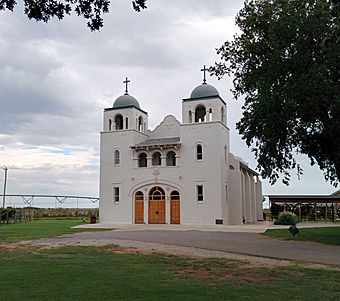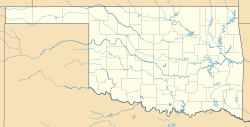Darlington Agency facts for kids
Quick facts for kids |
|
|
Darlington Agency Site
|
|

Darlington Chapel
|
|
| Nearest city | El Reno, Oklahoma |
|---|---|
| Area | 3 acres (1.2 ha) |
| Built | 1870 |
| NRHP reference No. | 73001557 |
| Added to NRHP | August 14, 1973 |
The Darlington Agency was a special government office set up for the Cheyenne and Arapaho Indian Reservation. It was located in what is now Canadian County, Oklahoma. This agency was created in 1870. It was moved from Fort Supply to be easier for the tribes to reach. The agency was named after Brinton Darlington, a Quaker man who was the first United States Indian agent there. He worked at the agency until he passed away in 1872.
The Darlington Agency grew to have its own post office and a school for Native American children. John Homer Seger ran this school. The agency also became a stop on the famous Chisholm Trail, a path used to move cattle. By 1880, the agency even had its own newspaper, called the Cheyenne Transporter. This was the first newspaper in the western part of Indian Territory.
In 1897, the Cheyenne people moved to start their own agency at Concho. Later, the Arapaho joined them there. After Oklahoma became a state, the Darlington Agency land became state property. A group called the Masons rented the site. They used it as a boarding school and a retirement home until 1922.
The Darlington Agency site was added to the National Register of Historic Places on August 14, 1973. This means it is recognized as an important historical place.
History of the Darlington Agency
The Darlington Agency was set up in 1870 on the Cheyenne and Arapaho Reservation. In 1874, Fort Reno was built close to the agency. Agent John Miles asked for the fort to be built to help keep peace with the Arapaho and Cheyenne people.
At first, Buffalo Soldiers from the 10th Cavalry were sent to set up a camp near the agency. But they were moved to the Wichita Agency, about 30 miles (48 km) south, because of problems there. Then, soldiers from other forts came to Darlington. They were led by Lt. Col. Thomas Neil.
Neil was allowed to choose a spot south of the North Canadian River. He built corrals for animals, a wagon yard, and dug wells. He also set up a sawmill for the military post. In February 1876, General Phil Sheridan officially named the new place Fort Reno.
In December 1876, S. A. Galpin visited the Darlington Agency. He worked for the Office of Indian Affairs. His report about the agency was mostly positive. He was very impressed by the school there. He wrote that it was "... the largest, and in many respects the best, Indian school that I have found." At that time, John H. Seger was running the school. It had 115 students. Galpin noted that the school was in excellent condition.
In 1877, a Cheyenne leader named Dull Knife and about 900 other Cheyenne people were brought to Darlington by US troops. The next year, most of this group escaped. They tried to go back to their homeland in the north. Soldiers from Fort Reno and other posts chased them. Most of the escapees were caught and brought back to Darlington.
Soldiers from Fort Reno also helped protect the Native Americans. They removed people called Boomers and ranchers. These people were illegally using reservation land for their cattle. In 1889, the soldiers fought against Sooners. Sooners were people trying to sneak into Oklahoma before the land was officially opened for settlement.
By 1880, the Darlington agency started its own newspaper, the Cheyenne Transporter. It was the first newspaper in western Indian Territory. The Cheyenne people left in 1897 to create their own agency at Concho. When the Arapaho joined them, both tribes used the Concho agency.
The Darlington Agency land became property of the State of Oklahoma in 1907. The Masons rented the site. They ran a boarding school and a retirement home there until 1922. After that, the state used the land for the Oklahoma Department of Wildlife Conservation. It became a main bird hatchery and research station.
The site was added to the National Register of Historic Places on August 14, 1973.
Fort Reno's Later Years
Fort Reno became a "remount station" in 1908. This meant its main job was to provide animals, mostly horses, to other military groups. By 1938, military units were using more machines instead of horses. So, Fort Reno became a supply depot. During World War II, Fort Reno was used as a camp for German soldiers who had been captured.
In 1949, the fort was given to the U.S. Department of Agriculture (USDA). They used it as a research station for livestock. Today, it is known as the Darlington State Game Farm.
See also
- Battle of the Washita River
- Fort Reno



